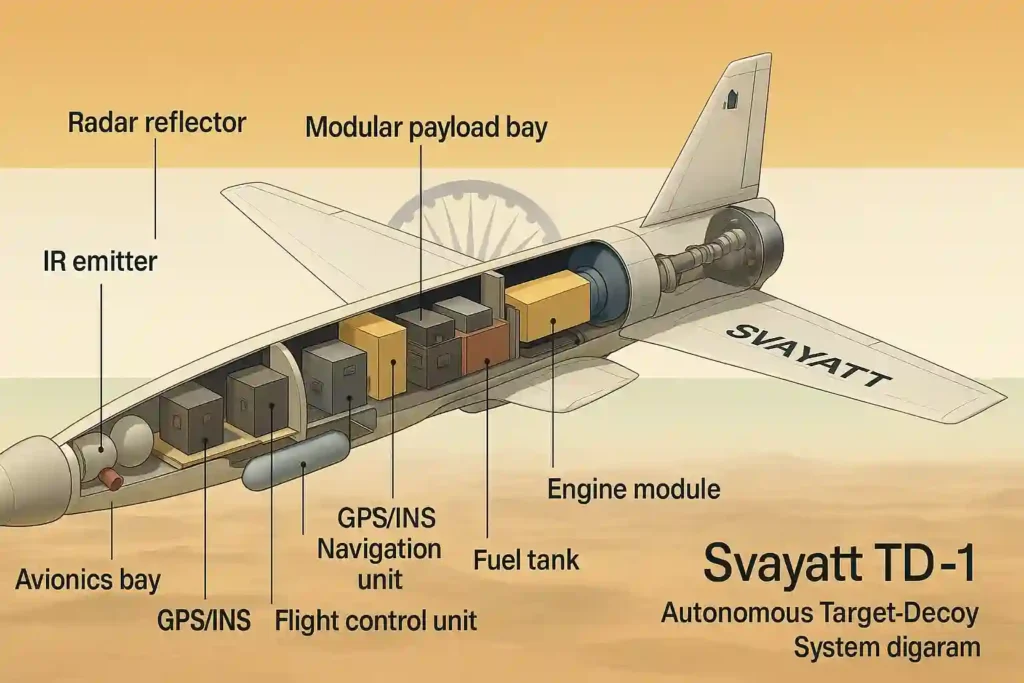If you’ve been wondering how India is preparing its armed forces to deal with new-age aerial threats, you’re in the right place. With enemy drones, stealth aircraft, and hypersonic weapons now shaping future warfare, the need for cost-effective and realistic training tools has never been more urgent.
That’s where the Svayatt TD-1 steps in.
On 21st June 2025, Hyderabad-based Paninian India Pvt Ltd officially unveiled this game-changing drone: an indigenous Autonomous Target and Decoy System built specifically to train, test, and simulate complex air combat scenarios. Whether you’re a defence enthusiast, a policymaker, or just curious about India’s technological advances, this article answers all your questions about Svayatt TD-1 — from its working mechanism to why it’s a turning point in our journey towards self-reliant defence.
What Is Svayatt TD-1?
A Technological Overview
Svayatt TD-1 is a state-of-the-art UAV platform designed to replicate a wide spectrum of airborne threats. From simulating enemy fighter jets to mimicking cruise missiles or UCAVs, this system allows the Indian Armed Forces to test their air defence systems under realistic conditions.
Unlike traditional target drones that are limited to visual or radar targets, Svayatt TD-1 integrates infrared (IR) and RF signature modulation, GPS waypoint navigation, real-time telemetry, and ground control flexibility. This makes it a true multi-spectral simulation tool.
Developed with Purpose
The drone is controlled via an indigenous Ground Control Station (GCS) and is designed for compatibility with India’s radar, missile, and EW testing infrastructure. This removes the traditional roadblocks of foreign OEM software restrictions or high-maintenance imports.
Detailed Features and Capabilities

Dual Role: Target and Decoy
- Acts as a high-speed aerial target for live missile trials.
- Functions as a decoy platform for electronic warfare testing, simulating enemy jamming and spoofing behaviours.
Payload Modularity
- Enables rapid and efficient payload swaps, effectively supporting infrared emitters, radar reflectors, electronic countermeasure (ECM) modules, and jamming pods.
- Can simulate low, medium, or high radar cross-sections depending on the training mission.
Signature Emulation
- Emulates radar, thermal, and electronic characteristics of multiple threat platforms such as drones, cruise missiles, or fighter aircraft.
- Can mimic the signature of specific adversary platforms for exact test matching.
Real-Time Telemetry and Control
- Operators can re-route, pause, or retarget the drone mid-flight.
- Supports autonomous mission plans with dynamic adjustments via GCS.
Cost and Logistical Benefits
- Fully reusable with low operating cost.
- Manufactured locally, reducing the turnaround time for parts and maintenance.
Built for Indian Conditions
- Operates in deserts, mountains, coastal zones, and jungle environments.
- Field-tested at various DRDO and IAF facilities to ensure readiness under Indian terrain and weather.
Operational Use Cases of Svayatt TD-1
Missile Trials
From Akash-NG to QRSAM, missile developers rely on realistic targets to validate seeker accuracy, guidance logic, and kill probability. Svayatt TD-1 fills this need efficiently.
Radar Operator Training
Simulating fast, erratic, and signature-altering targets trains radar crews for high-stakes situations. The drone’s ability to vary RCS in real time improves operator confidence and preparedness.
EW System Testing
Svayatt TD-1 emits spoofing signals or triggers specific radar modes to test Indian-made MAWS, DIRCMs, and radar decoys.
Integrated Battle Drills
During joint exercises, the drone can replicate swarming attacks or loitering munitions, helping teams coordinate command, control, and communication responses.
Why Svayatt TD-1 Is a Strategic Game Changer
Atmanirbhar Bharat in Action
For decades, India relied on foreign target drones, which were expensive and came with licensing restrictions. Svayatt TD-1 breaks this dependence, ensuring India controls the design, code, and upgrades.
Safer Training, Realistic Scenarios
By removing the need for live enemy aircraft or outdated systems, Svayatt allows India to conduct drills that are safer, more frequent, and more relevant to modern warfare.
Combat-Ready Armed Forces
The frequency and realism of simulations contribute directly to higher battlefield preparedness. This is especially important considering the changing security landscape in India.
Comparison: Svayatt TD-1 vs Imported Alternatives
Key Benefits Over Foreign Drones:
- Completely indigenous
- Environment-tested for Indian conditions
- Seamless compatibility with DRDO and IAF systems
- Lower cost per training hour
- Customisable payloads on demand
Challenges with Imported Systems:
- High cost of procurement and maintenance
- Limited payload options
- Integration delays with Indian radars and control systems
- Climate durability issues
Svayatt’s real-world compatibility and local manufacturing give it an unmatched edge.
The Team Behind Svayatt: Paninian India Pvt Ltd
Who Are They?
Paninian India Pvt Ltd is a defence technology company based in Hyderabad, specialising in autonomous unmanned platforms. Their mission is to bridge the capability gap in India’s defence ecosystem through modular, AI-powered, and scalable platforms.
Past Projects
The firm has developed AI-based drone swarms, stealth payloads, and smart jamming pods. With strategic partnerships across DRDO labs and private defence innovators, Paninian is leading India’s next-gen UAV frontier.
Vision Ahead
Future versions of Svayatt may include swarm AI logic, optical camouflage, and export-ready configurations. The team also aims to integrate LORA missiles and AI-behaviour modules into upcoming variants.
Supporting India’s Defence Industrial Growth
Svayatt TD-1 perfectly aligns with India’s broader defence ambitions:
- Boosts indigenous IP and engineering capability
- Reduces budget outflow on imported systems
- Opens up opportunities for defence export diplomacy
- Strengthens private-public collaboration in strategic tech
When combined with projects like AMCA, CATS Warrior, TAPAS UAV, and Ghatak UCAV, Svayatt becomes a building block in India’s future force multiplier strategy.
Final Thoughts: Built by India, Built for the Future

In today’s high-stakes security environment, Svayatt TD-1 is more than a drone — it is a symbol of India’s innovation, self-reliance, and tactical foresight. Designed, built, and deployed with Indian defence needs at its core, this platform demonstrates that India is no longer a follower in defence tech, but a leader.
As threats become harder to predict, Svayatt ensures India can train smarter, respond faster, and stay ahead.
